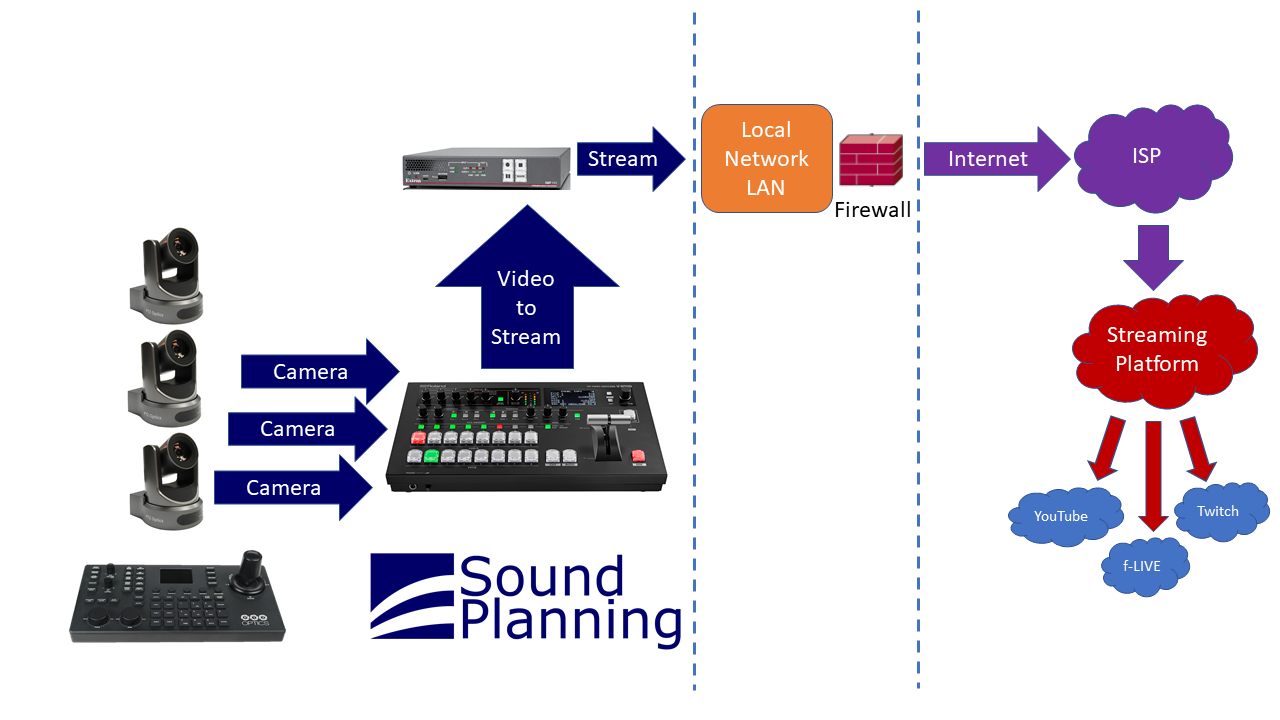|
Getting our clients up-and-running with a streaming camera setup has been a mostly positive experience. We have many success stories. But that's not what this post is about. This post is to better understand what it takes to produce successful streams. (the image above is from a video by Church of the Holy Spirit in Lake Forest using cameras, switching and TV carts provided by Sound Planning) Here are 7 Things Learned about Streaming Successfully:
Defining & Understanding Roles As the integrator, we are tasked with the design, integration and support of the hardware. In streaming, there are other parties involved that play crucial roles in a successful broadcast.
Sound Planning: Because we are integrating cameras and the related hardware with other components not under our control, we must get support and communications from the other players. The Local Network (LAN) Integrator needs to coordinate the ISP needs and the related hardware and infrastructure in the building to provide the quality of service needed for a successful stream. The ISP will need to provide the bandwidth and stability for the streams. The Streaming Provider must allow for the local team operator(s) to manage the streams, hosting and cataloging etc. Where to look for Bottlenecks If the quality of the stream is below where the output settings are. I.E. you are sending 720p/30FPS, but the quality looks like a video from a 2000 flip phone. Finding the point of this quality degradation is key. This is a common issue we get calls to resolve, but sometimes we cannot due to the point that we are in the flow of events. Managing Expectations Video productions vary to large degrees today. You can see handheld phone recordings up to professional cinematic quality on YouTube. Recognizing whether your organization's size and budget meets the level of expectations of the quality is a common occurrence. Be realistic of the level of staffing, equipment and budget that fits appropriately. There are churches that produce TV studio quality that have a staff to manage it, but they also have a 7-figure AV budget. (That is not an unrealistic number). Sound Planning isn't in the business of outfitting million dollar AV installations, we understand how to maximize production on a realistic budget! Building Community Attending online services shouldn't feel isolated. Make your attendees feel connected with an active chat room and/or a social media page that makes time to connect and engage. Don't leave them online with no interactive aspects. Finding & Holding Volunteers This technology does not run itself! Having a team of volunteers requires an active engagement and lots of communications between the clergy, musicians and the video stream team. This will take rehearsals and good documentation. Handing the keys to unprepared team members will leave them unmotivated to return. When to Staff There may come a time to pay for a staff or temporary support to manage the streaming and AV needs. Streaming vs. Recording Sometimes the best way to get a team up and running to streaming is by starting out recording then uploading the video to the streaming platform. Realtime broadcasting is a stressful endeavor! Recording sessions allows the team to learn the steps to a great broadcast without the failures being exposed. Once these steps are learned you will be ready to successfully stream! AuthorErik Saari, VP Sales & Systems Design
5 Comments
4/14/2021 06:58:37 am
Well outlined, Erik! This is completely in line with my experiences in this area. If you were to do a follow-on blog, maybe it could describe the different roles that the volunteers would be taking on, such as cameraperson, sound mixer (where the mix for video is distinctly different than the live mix!), graphics manager, video director, producer... the division of responsibilities and understanding of roles makes the team work.
Reply
Your comment will be posted after it is approved.
Leave a Reply. |



